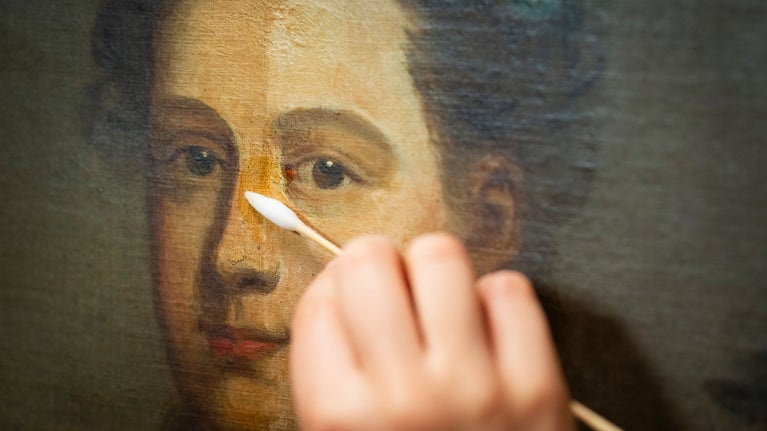The Portrait of Lady Ann Bligh: A Historic Arrival
The portrait of Lady Ann Bligh is the only known depiction of this rather elusive 18th-century doyenne of Castle Ward, making it an invaluable addition to the house collection. Lady Ann, the wife of Bernard, 1st Viscount Bangor (1719–1781), is likely to have been closely involved in the project to design Castle Ward’s distinctive house and its landscape setting in the 1760s. While portraits of her husband and three of her children have long been on view in the house, Lady Ann herself has been absent until now. This newly acquired painting offers fresh insight into women’s history at Castle Ward, enriching our understanding of a woman whose contributions to the place have been marginalised over the past 250 years.
To ensure its preservation, the painting and its frame have undergone a programme of conservation at the National Trust’s Royal Oak Foundation Conservation Studio, located at Knole House, Sevenoaks. This work allows for full appreciation and safe display of the portrait, bringing Lady Ann’s story to life for visitors. Her arrival at Castle Ward marks a momentous occasion, reconnecting the house with one of its most significant characters.
A Carefree Spirit
A wealthy widow, the daughter of an earl and a distant relation of Queen Mary and Queen Anne: Lady Ann Bligh was a ‘good catch’ for the Ward family, which had been steadily increasing its standing and influence since establishing a base in Ireland in the late 1500s. Described at the time as ‘a young lady of very good character,’ she seems to have had a good deal of spirit – her husband Bernard called his sailing ship the Blyth Ann, referring to her light-hearted, carefree personality. She enjoyed the lively social life of the London season and of fashionable resorts such as Bath and Scarborough. Her portrait transmits a confident air – a young woman taking full advantage of the benefits of a privileged lifestyle.
Lady Ann married Bernard Ward in 1748. At first the marriage seems to have been a success, but after bringing up a large family, their relationship broke down. Both strong-willed characters, the distance between them became insurmountable. Lady Ann set up a separate establishment in Dublin, eventually moving to Bath in 1772. The house she had helped to design was still not quite complete when she left Castle Ward for the last time.









